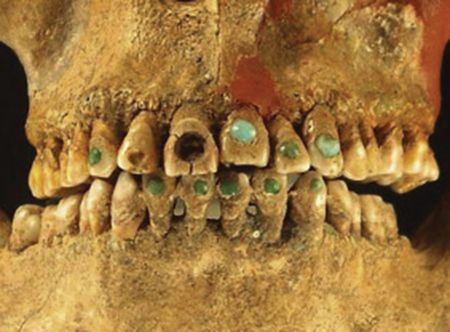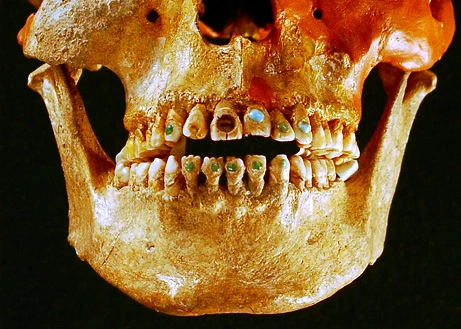Modern dentistry could learn a few lessons in bling from the Mayans – as they stuck colourful gemstones made of jade and turquoise on their teeth. However, recent research suggests that the stones served not only as decorations but also had therapeutic benefits.

The Study
Research led by Gloria Hernández-Bolio from Cinvestav, Mexico, explored the sealants used by ancient Mayans to affix gemstones to their teeth. The team, consisting of scientists from Universidad Autónoma de Yucatán, Harvard University, and Brown University, analyzed eight teeth discovered in Maya burial sites dating between 200 and 900 C.E.

Discoveries and Analysis
The researchers identified 150 organic molecules commonly found in plant resins within the samples. These organic compounds, known for their water-repelling and adhesive properties, were used in the sealants.
Notably, the sealants were found to possess antibacterial properties, potentially contributing to the maintenance of oral health among the ancient Mayans.
The Gemstone Application Process
The indigenous peoples of Mesoamerica believed that their breath was a divine link, prompting them to polish and fill their teeth with precious gemstones for purification purposes. The Mayan dentists would drill holes through the enamel and into the dentine before affixing the gemstones using a durable sealant.
The Composition of the Sealants
Prior analyses in 1971 revealed the presence of inorganic materials similar to cement and hydroxyapatite, a mineral derived from ground teeth and bones. These components helped strengthen the sealant but did not provide adhesive properties.
In the recent study, Hernández-Bolio and her team discovered that many of the sealants used pine tree extract, known for its antibacterial properties. The researchers also found evidence of sclareolide, a compound found in Salvia plants, which possesses antibacterial and antifungal properties.

The composition of the sealants varied depending on the location, indicating that local practitioners developed their unique recipes. For example, sealants from the outer Copán region included essential oils from mint plants, potentially offering anti-inflammatory effects.
Implications and Speculations
The findings shed light on the Mayans’ advanced dental care practices and their potential knowledge of medicinal plants. The remarkable dental health of individuals such as Kʼinich Janaabʼ Pakal, a Maya king, raises questions about the longevity and preservation of teeth in that era.
While some attribute Pakal’s intact teeth to softer foods, others argue that it highlights the exceptional dental care provided by the Mayan people.

Conclusion
The ancient Mayans’ use of gemstones on their teeth not only added a touch of bling but also demonstrated their awareness of the therapeutic benefits. The study’s findings provide valuable insights into the historical practices of oral health maintenance and the innovative use of natural resources.
